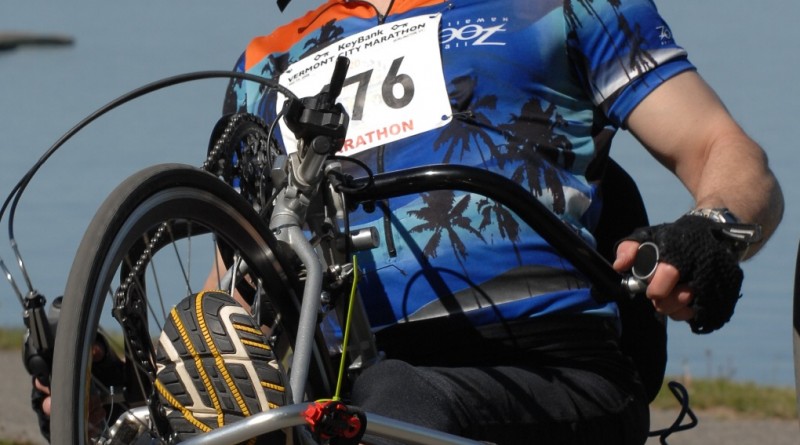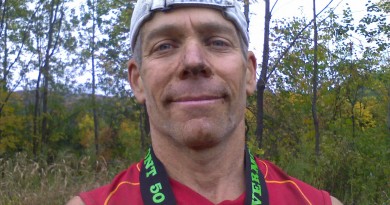Eric Rose | Reader Athlete May 2012
 Age: 50
Age: 50
Residence: Manchester Center
Family: Wife, Christina; son David, 16
Occupation: Network administrator
Primary sports: Sled hockey, downhill skiing, hand-cycling
Before he became paralyzed while snowboarding at Stratton, Eric Rose had never run a marathon―he had been strictly a 5K racer who hated the only 10K he’d ever done. These days, as soon as tickets for the Vermont City Marathon are available online, he’s often the first person to sign up.
VS: How many marathons have you done?
ER: I’ve done five VCMs and two other races: The Shires of Vermont, which goes from Bennington to Manchester, and the Adirondack Distance Festival in Schroon Lake. The Shires is the only race I didn’t finish. It was pouring rain and cold, and it’s a hilly course with dirt roads and lots of potholes. It was a great group of people and pretty scenic, but it’s very challenging for hand-cyclists.
VS: What’s the best part of VCM?
ER: It’s wonderful to have all those people out there cheering you on. It’s a really great feeling and makes you feel pretty special. The fact that it’s so welcoming is what makes it such a popular race. Hand-cycling through Burlington for two hours at top speed and screaming down Church Street at 25 mph is also pretty cool.
VS: What was your most memorable race?
ER: Definitely my first VCM in 2007. I had just recently been paralyzed, and it was a life-changing experience. I felt like a celebrity, and I had so much fun. I smiled the whole time. I think people still talk about the guy on the hand-cycle who kept smiling through the race. When I finished, I said I’d never miss another one. I spent more time waving to people than focusing on the race.
VS: Why do you enjoy racing?
ER: For me, it’s not so much the race but the ability to ride a hand-cycle as fast as I can without having to worry about anything in the road. It’s a feeling of freedom that you can’t get on a non-race day. Hand-cycling has certain risks because of your low visibility for cars, so I could never go all out on the street. You can’t go full speed on the bike path either because of all the people. Some guys train really hard and want to win, but I just like the feeling of riding all out in such a prestigious race. About a week after my first VCM, I was riding with Patrick Standen [president of the Northeast Disabled Athletic Association] on the bike path, and as we went by a house, I told him I remembered that a guy had come out in his pajamas with a cup of coffee to sit on the steps as we went by. I could remember lots of the people I saw on the route, but Patrick was so focused on the race that his eyes were always just straight ahead.
VS: Were you a hockey player before you started playing with the Vermont Sled Cats?
ER: I had hockey skates, and I’d skated at the local rink and on ponds with my son, but I’d never played hockey. Several months after I was injured, I heard that the Sled Cats were going to play an exhibition game against the New York Rangers to benefit the Bart J. Ruggiere Adaptive Sports Center at Bromley, and I wanted to go and watch. When I got there, the organizers offered to get me on a sled and I agreed. Then I learned the Rangers only had four players, so I was enlisted to join them; my first time ever playing hockey. I was laughing the whole time, and when it was over, I asked to join the Sled Cats.
VS: At least with sit-skiing, you had some background.
ER: Actually, Alpine sit-skiing has a pretty significant learning curve. I think it’s just like learning a new sport. The only similarity to Alpine skiing is that it’s cold and there’s a chair lift. It took me a few years to get into it, but it’s another expression of freedom. This winter was my big breakthrough. I finally made it from the top to the bottom of the mountain without falling, and I was able to take the chairlift by myself. I was all excited and then the season ended early, so I’m already thinking about where to get my season’s pass next year.
VS: Do you do other sports?
ER: In the summer, I kayak and swim and I’m a competitive sailor. I also play wheelchair tennis but not competitively. I’ve started Nordic skiing, which is an incredible amount of work for your upper body, but it’s nice because my wife can snowshoe with me when I do it. I also water-ski, which is a little different because it’s a high-impact sport with motors and noise, and I’ve joined a group that brings adaptive gliders to Saratoga Springs, which is really fun. I’d also like to try biathlon. I went skeet shooting recently, and I enjoyed it even though I’d never shot a gun before.
VS: This is probably a silly question, but are you looking forward to this year’s VCM?
ER: Absolutely. VCM is such an awesome experience. I tell anyone I meet who is injured that they have to do the race. It’s such a great course, particularly the way it ends with 5 miles on the bike path. The Adirondack Distance Festival ends on a hill that had me crying, but here, you get on the bike path at mile 20, and whatever energy you have left you can burn off. There’s only one big hill and that has the Taiko drummers and people cheering you on. It’s a neat experience because you get to be out in front, ahead of some of the best runners in the world. I owe a lot to sled hockey and the VCM. Without them, I’d just be sitting home and watching TV.


